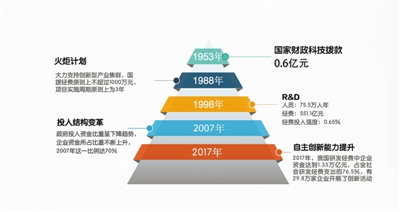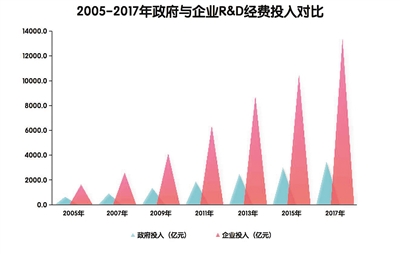

Investment of R&D funds from 1953 to 2017


Sharp tools make good work. Investment in science and technology is the necessary condition and basic guarantee for scientific and technological progress. Since the founding of New China 70 years ago, China has gradually established a national science and technology investment system that adapts to the characteristics of the socialist market economy system.
"The continuous improvement of the national science and technology investment system and the sustained and rapid growth of research and development (R&D) funds have stimulated the vitality of scientific and technological innovation in the whole society and strongly supported the country’s scientific and technological progress and rapid and stable economic and social development." Zhu Yingchun, deputy director of the Institute of Science and Technology Statistics and Analysis of the China Academy of Science and Technology Development Strategy, said in an interview with the Science and Technology Daily reporter.
A historic breakthrough was achieved in the scale and intensity of R&D funds.
The R&D expenditure of the whole society is an important component of the national (regional) investment in science and technology, an important indicator to measure the national (regional) investment in science and technology, and an important indicator to observe and analyze the national (regional) scientific and technological development strength and competitiveness.
Since the founding of New China, especially since the reform and opening up, with the promulgation and implementation of various national economic policies and science and technology policies and the enhancement of the country’s comprehensive national strength, the investment in science and technology in the whole society has increased rapidly, and the scale and intensity of R&D funds have achieved a historic breakthrough.
Data from the National Bureau of Statistics show that in 2018, China’s R&D expenditure reached 1,967.79 billion yuan, 123 times that of 1991, from 1991— In 2018, the average annual growth rate was 19.5%, far exceeding the average annual growth rate of GDP at current prices in the same period.
At the same time, the investment intensity of R&D funds has hit record highs, reaching 2% for the first time in 2013 and 2.19% in 2018, exceeding the average level of the 15 EU countries. According to the exchange rate, China has become the second largest R&D investment country in the world after the United States, providing a strong financial guarantee for the development of science and technology.
China’s national financial expenditure on science and technology increased from 60 million yuan in 1953 to 951.82 billion yuan in 2018. 2005— In 2010, the national fiscal expenditure on science and technology grew fastest, with an average annual growth rate of more than 20%. In 2011, the growth rate began to decline, and in 2018, it increased by 13.5% over the previous year, setting a record high since 2013.
"The national financial expenditure on science and technology has played a key role in driving the whole society’s R&D investment and leading the national strategic orientation, providing a strong guarantee for scientific and technological innovation." Zhu Yingchun pointed out.
In Zhu Yingchun’s view, the investment in science and technology has increased rapidly, and the scale and intensity of R&D funds have achieved a historic breakthrough, which is in line with the Outline of the National Medium-and Long-term Science and Technology Development Plan (2006— The promulgation and implementation of "2020)", especially since the 18th National Congress of the Communist Party of China, various departments and localities have taken active measures, and the whole society has formed a consensus on attaching importance to and supporting innovation.
From different regions, the performance of scientific and technological investment in some places is eye-catching. In 2017, the fiscal expenditure on science and technology in seven regions including Guangdong, Jiangsu and Shanghai exceeded 20 billion yuan. The local fiscal expenditure on science and technology in 11 provinces (cities) accounted for more than 2% of the local fiscal expenditure, and Guangdong, Shanghai and Beijing all exceeded 5%.
It is worth mentioning that in 2018, the number of regions with R&D investment intensity greater than 2% increased to 11, among which the R&D investment intensity in Beijing reached a record high of 6.17%.
Enterprises become the main force supporting the growth of R&D investment.
Since the reform and opening up, China has actively guided other social capitals to increase their support for innovation through direct and indirect financial investment. Enterprise funds have gradually become an important source of funds for the whole society to invest in R&D funds.
"In recent years, the source structure of R&D funds has been further optimized, and the dominant position of enterprise innovation has been further highlighted. The proportion of corporate funds in R&D funds increased from 60.1% in 2003 to 76.5% in 2017. " Zhu Yingchun believes that this is mainly due to the improvement and implementation of the R&D expenses plus deduction policy, the tax relief policy for high-tech enterprises and the accelerated depreciation policy for fixed assets, which greatly mobilized the enthusiasm of enterprises for R&D activities. As the main body of technological innovation, enterprises have become the main force supporting the growth of R&D investment in China in recent years.
Enterprises are not only the main body of investment in R&D funds, but also the main body of implementation. From the perspective of expenditure structure, the proportion of R&D expenditure of Chinese enterprises in the total social R&D expenditure has increased from about 60.0% in 2000 to 77.4% in 2018.
According to statistics, in 2017, the number of enterprises enjoying R&D expenses plus tax reduction and exemption for industries above designated size and tax reduction and exemption for high-tech enterprises reached 24,400 and 24,200 respectively, 3.3 times and 3.5 times that of 2009 respectively, and the amount of tax reduction and exemption reached 57 billion yuan and 106.2 billion yuan respectively, which played a positive role in encouraging and guiding enterprises to carry out R&D activities.
In 2018, the basic research funds broke through the 100 billion yuan mark for the first time.
Data from the Statistical Bulletin of National Science and Technology Investment in 2018 (hereinafter referred to as the Bulletin) show that in 2018, China invested a total of 1,967.79 billion yuan in R&D, an increase of 207.18 billion yuan or 11.8% over the previous year. Among them, the basic research funds exceeded 100 billion yuan for the first time, reaching 109.04 billion yuan, keeping pace with the investment in research and development.
Li Yin, a statistician of the Department of Social Sciences and Literature of the National Bureau of Statistics, explained that the funds for basic research exceeded 100 billion yuan, and all three subjects achieved rapid growth. The funds for basic research in institutions of higher learning, government-owned research institutions and enterprises were 58.99 billion yuan, 42.31 billion yuan and 3.35 billion yuan respectively, up by 11.1%, 10.1% and 15.7% respectively over the previous year. Among them, colleges and universities contribute 51.1% to the growth of basic research funds in the whole society, and they are the main bodies to carry out basic research.
According to Lv Wei, a researcher in the Innovation and Development Research Department of the State Council Development Research Center, the investment in basic research in China has been increasing continuously in recent years, which is not only related to the state’s attention, but also an inevitable requirement for the development of technological innovation capability to the stage of "three runs coexist". The report of the 19th National Congress of the Communist Party of China proposed that we should aim at the forefront of world science and technology, strengthen basic research, and achieve a major breakthrough in forward-looking basic research and leading original achievements.
Over the past 70 years, China has made remarkable progress in science and technology investment. "However, it should still be noted that compared with the goal of deepening the supply-side structural reform and building a world science and technology power, the investment intensity of R&D funds in China needs to be rapidly improved." Zhu Yingchun pointed out.
Judging from the cumulative investment, there is still a big gap between the total investment of R&D funds in China and the United States and Japan since 1991. Science and technology investment has a strong cyclical accumulation effect, and the appearance of scientific and technological innovation effect depends on long-term investment and continuous accumulation. When the innovation ability changes from "tracking, paralleling and leading" to "paralleling" and "leading", it still needs the support of a lot of scientific and technological investment to achieve key core technological breakthroughs.
At the same time, problems such as unbalanced investment structure of R&D funds have yet to be solved. For example, the single source of funds for basic research. The proportion of basic research funds in China has been around 5% for a long time, which is lower than 15% in developed countries & mdash; The general level of 20%; Basic research is highly dependent on the central financial input, and local and enterprises have insufficient investment in basic research.
In this regard, Zhu Yingchun suggested that in the future, we should speed up the construction of a diversified investment system, strengthen the comprehensive design of fiscal, taxation, financial and other policies, form an organic policy system, and further guide venture capital, charitable donations, and universities’ own funds to invest in R&D activities. (Reporter Tang Ting)